I am an icon painter, Russian Historian and Austin Web Designer formerly of Seattle, Washington and now living in Austin, Texas. My interest in Byzantium and icons began when I was 8 years old and read my first book on Byzantium called "The Fall of Constantinople". In second grade I made a 100 page long "Joshua Scroll" relating the experiences of me and my classmates in Constantinople which was illustrated with panoramic scenes of the Great City. I wish I had saved it.
It was almost impossible for me to find books on Byzantium, we only had two in my elementary school library and I checked them out over and over again. I remember how excited I was on my first visit to the library in the small town I grew up in, where I discovered a dozen or more books on Constantinople and Byzantine history. I felt like the world was opening up for me to see real pictures of Hagia Sophia for the first time.
I have no explanation for why I became an artist and painted icons. No one in my family has ever shown any interest in art or history except for me. There is nothing in my family tree or DNA to indicate where it came from. As far as the rest of my family is concerned our most important ancestor was Thorfinn Torf-Einarsson, also known as Thorfinn Skull-Splitter, who was a 10th-century Norse-Viking Earl of Orkney. Here's a picture of my nephew Dan and his wife Maria dressed in tribute to Thorfinn. Yes, we know that Vikings didn't wear horn helmets like that! BTW, Dan is an Ironman - Thorfinn would be proud!
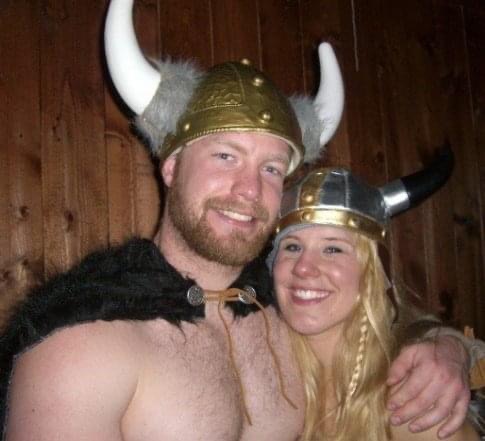
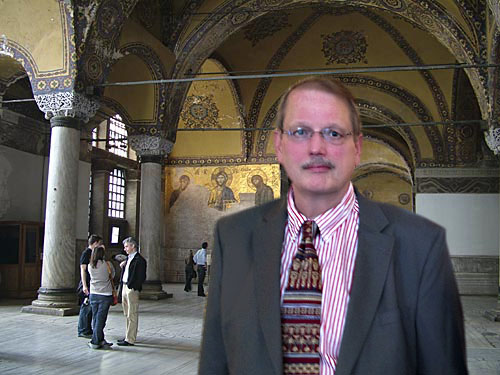 Wanting to create my own virtual Byzantium at home, I painted the walls of my bedroom with life-sized saints, Christ and angels. I created my first icons when I was 9 and opened my own 'Byzantine Museum' in my bedroom. Not having any Byzantine artifacts of my own, I created mosaics, crosses, sculptures and reliquaries to stock the exhibit cases in my room. I created my own guidebooks to this 'collection' and issued free tickets to kids in my neighborhood. I was both curator and docent for these exhibitions.
Wanting to create my own virtual Byzantium at home, I painted the walls of my bedroom with life-sized saints, Christ and angels. I created my first icons when I was 9 and opened my own 'Byzantine Museum' in my bedroom. Not having any Byzantine artifacts of my own, I created mosaics, crosses, sculptures and reliquaries to stock the exhibit cases in my room. I created my own guidebooks to this 'collection' and issued free tickets to kids in my neighborhood. I was both curator and docent for these exhibitions.
I remember I painted my room when my parents were away on vacation. I was really pleased - really excited - about what I had created. When my mom got home she came into my room she looked around and said "Oh my God, just wait until your father sees this". She was worried he was going to blow his top when he saw what I had done. Anyway, after my dad saw the room his only comment was "Not bad". That sounds like nothing but it meant a lot to me - that was the first and only time my father said anything about my art, even when (years later) I won awards, was in the news and on TV about my work. Years after I left home my father preserved the room exactly like it was. My mom told me he would go in there and and sit and look at everything. When my mom died my father remarried and sold the house. I understand the people who bought it were scared to touch the room or alter the decoration, so it remains just as it was. Perhaps one day I will get to see it again.
My parents never discouraged me in the development of my artistic talent, they were just sort of mystified about it. Our house was full of paintings I did. The largest was a huge 7 foot wide painting I did of Saint Francis of Assisi and Saint Clare kneeling in a church with candles. They put everything up but never asked what they represented of why I did them. Perhaps they just saw them as evidence of my compulsive creativity. I once made a vow that I would create three works of art everyday of my life and I kept that up until a few years ago. I was also a potter and a sculptor. When I was in my late teens I designed record covers for Christian rock bands.
My art teachers were supportive and tried to push me beyond the limits of my skill and technique. They wanted me to paint as big as possible and encouraged me to be radical in the concepts or subject matter I was using in my paintings. They criticized me for painting people who were too beautiful and idealized. I was attracted to the works of the Pre-Raphaelites and the Nazarenes. I was not a modernist. My paintings were devoid of emotion and icy. If I got bored with a painting I would just leave it and not finish it.
My parents had no interest in religion and we never went to church, although we had a Bible in the house; one of the dozen books we had. That Bible was very scary, full of frightening engravings of the Last Judgement and the torments of Hell. I was afraid to open it, I really thought all of those horrible things were going to occur at anytime. There was one picture I remember of God casting down Lucifer and his angels. These images gave me nightmares and I didn't have anyone I could ask about them and what they meant.
The first 'official' sort of icon I painted was for Saint Demetrios Church in Seattle. I remember it was the first Orthodox Church I ever visited and it was Easter. I went on a school field trip that involved seeing how various religions and churches worshiped. Anyway, I brought an icon I painted of the Archangel Michael. I was going to give it to the priest but I was too embarrassed and just left it outside the door to the rectory. I left it in a bush. Years and years later I went back to Saint Demetrios and saw my icon. I told the priest I had painted the icon when I was a kid and left it in the bush. He laughed and said "well that solves a mystery, please don't tell the old ladies of this church, they think it's a miraculous icon that just appeared in the bush on its own!"
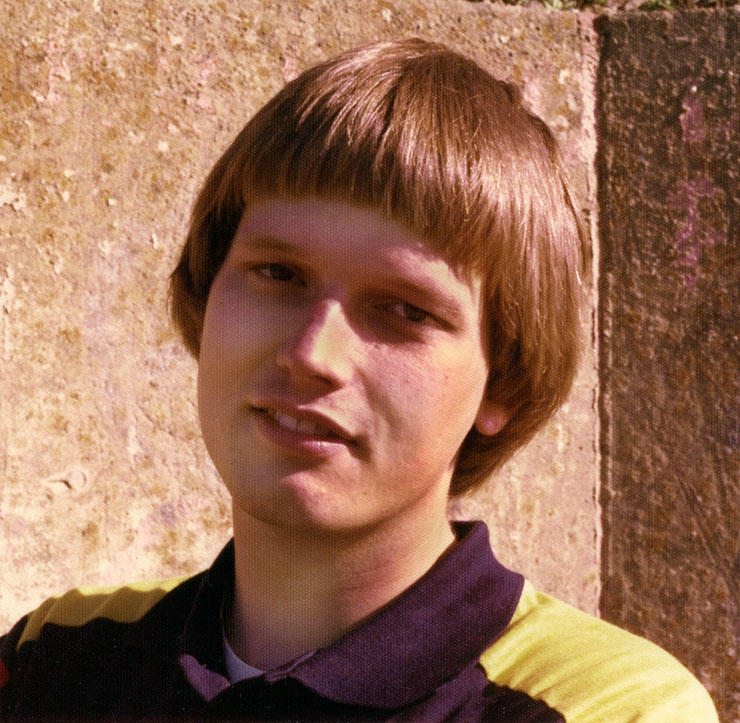 I was 6'5" tall when I was in 6th grade, 12 years old. I was a giant, that is the reason was never bullied or bothered about my art when I was in school. Everyone was afraid of me. I won many awards for my art when I was in Junior High and High School, I suppose kids gave me a break because I had talent, too, besides my size. I had two brothers who were much shorter than I was, we all looked like Vikings. My nickname was Atch, my younger brother was Itch, and the youngest and smallest of us was called Scratch. Both of my brothers were major athletes and hunters. I had no interest in shooting deer, bear and elk. My grandfather was a butcher so all that game ended up on our dinner table. I hated elk burgers and bear hot-dogs was even worse. My father decided I needed toughening up so one night he locked me in the garage were 4 deer were hanging from the rafters and dripping blood. I had to watch them staring at me all night in the darkness. Early in the morning I broke out off the garage and ran away from home for a few days. Our house was loaded with guns of all types and sizes - and there were bullets everywhere. Our house always reeked of gun cleaning supplies. Most of the guns were kept in my bedroom - right alongside the frescoes I had done in there. My parents never saw a conflict between Christ, the Prince of Peace and 24 rifles in wooden racks next to each other.
I was 6'5" tall when I was in 6th grade, 12 years old. I was a giant, that is the reason was never bullied or bothered about my art when I was in school. Everyone was afraid of me. I won many awards for my art when I was in Junior High and High School, I suppose kids gave me a break because I had talent, too, besides my size. I had two brothers who were much shorter than I was, we all looked like Vikings. My nickname was Atch, my younger brother was Itch, and the youngest and smallest of us was called Scratch. Both of my brothers were major athletes and hunters. I had no interest in shooting deer, bear and elk. My grandfather was a butcher so all that game ended up on our dinner table. I hated elk burgers and bear hot-dogs was even worse. My father decided I needed toughening up so one night he locked me in the garage were 4 deer were hanging from the rafters and dripping blood. I had to watch them staring at me all night in the darkness. Early in the morning I broke out off the garage and ran away from home for a few days. Our house was loaded with guns of all types and sizes - and there were bullets everywhere. Our house always reeked of gun cleaning supplies. Most of the guns were kept in my bedroom - right alongside the frescoes I had done in there. My parents never saw a conflict between Christ, the Prince of Peace and 24 rifles in wooden racks next to each other.
We started fishing when we were 5 or 6 years old. When we caught a fish I would always let it go or try to save them in buckets. There was woman who lived near us who had big tanks full of salmon and rainbow trout and I would bring them to her secretly. We lived in salmon country and every week a huge salmon would arrive that one of my relatives had caught. My mom would gut and clean them in the kitchen. For years after that I hated salmon. That was strange for a native of the Pacific Northwest.
Once when we went to the Pike Place Market in Seattle I tried to ransom a big fish in a tank and save its life. The guy reported me to my parents. I have no idea what happened to the fish.
When our relatives visited us from Valley Mills, Texas, they would always bring rattlesnake meat, tails and fangs that they had killed in the backyard with a hoe. My great-grandmother used to kill them by chopping their heads off with a hoe. Can you imagine that! When my brother last visited me here in Austin we went to Valley Mills. Both of us hate snakes. I did search on rattle snake Valley Mills to see if I might run into some when we went there. On the first screen of image results there were MANY pictures of huge fat rattlers from Valley Mills, they were shown slithering down the main street. I called the Chamber of Commerce to ask what were the chances of us run into any of them when we got there. She told me nit to worry that most of the snakes lived in the cemetery. You guessed it, we were going to Valley Mills to visit the graves of our ancestors in THAT cemetery. The nice woman told us that the snakes lived in holes and only came out in the heat. We didn't see any during our visit. I asked a woman in a restaurant if she had seen any rattlesnakes recently - she laughed and said "so you must be those two scared boys" everyone is talking about. She told us she never worried about them because she always carried a gun. If you do a search on the web for "Valley Mills rattlesnakes" you will see the six-foot long, fat ones I am taking about.
My father made one last attempt to convert me to firearms and hunting by offering me my pick from any of of his guns, pistols and rifles to start my own collection. I had to pick one but I took no interest in it afterwards. After I left home whenever I came back at Christmas my dad was always wrapping up that gun and trying to persuaded me to take it with me, warning how much I needed it in California. My surviving brother is an avid hunter and owner of firearms. He has most of my Dad's collection, including "my" gun.
I painted my first copy of the Deesis when I was in High School - 1966 or 67 - so I was 14 or 15 at the time. I painted a miniature on a hard-wood domed box I found in an antique store. I painted small mosaic cubes around it in gold. It was in an art show and someone bought it. Two years ago the woman who bought it found the website and contacted me to say she still had it and how much he had meant to her, she was an Orthodox Christian whose family moved to Seattle from Alaska. Since then I have painted it at least 20 or 30 times. It is the hardest icon for me to copy, even when I trace it from a print.
I have always mixed my own colors and made my own icon boards, covering them in linen and gessoing them. I can never forget the smell of rabbit skin glue when I would heat it up. The most expensive thing I had to buy was gold-leaf - and I had to teach myself how to water-gild from old books. There wasn't anyone in those days who could teach you how to make icons. My biggest problem was I always tried to rush things.
I received lots of commissions when I was young and also painted five churches. I always received lots of support from friends who admired my work and wanted to see me succeed. I tried as often as I could to paint for free for churches, monks or nuns. I always felt guilty to charge for the talent God had given me. Perhaps people thought I was strange.
Today as an adult I continue my interest in Byzantine studies and painting icons. I have traveled to Istanbul and other parts of Turkey on a number of occasions. I have always been outside the closed realm of Byzantine scholars. For a long time I tried to get them to help me with this site, but it never worked out. I used to feel like I had to have "professional" Byzantinists to validate my work on the site. I am a terrible writer - and writing the articles is difficult for me. Since I have done it myself I don't have anyone except myself to correct the work. That means it goes faster I I don't have to wait for anyone to approve what I do. I make all of the graphics and images myself.
The catalyst for this website, which was launched in 2008, was my interest in and devotion for the icon of the Christ from Hagia Sophia.
I suppose I always have Tuesday, May 29 1453, in the back of my mind, the day Constantinople fell and Hagia Sophia became a mosque. I wish I could somehow undo those two facts, perhaps I would wake up and Byzantium would still be alive, had never fallen to the Turks. I don't think I'm the only one who has that dream, but I know it will never happen. But, with this website hope I can breathe life into the Byzantines and restore Hagia Sophia in spirit to its glory days.
Here's a picture of some icons I have painted in my library. I didn't do the small pointed-arch one, that's a print.

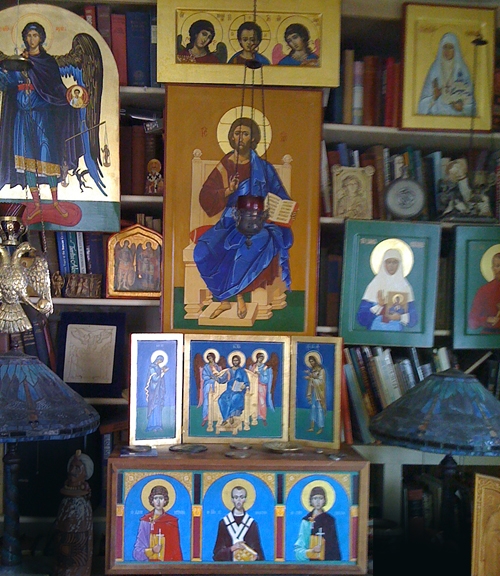
![]()
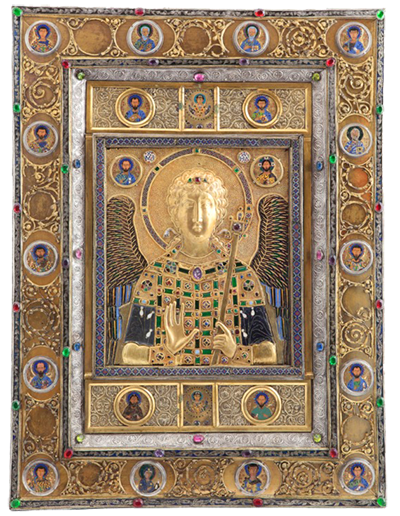 Icon Panel of the Archangel Michael
Icon Panel of the Archangel Michael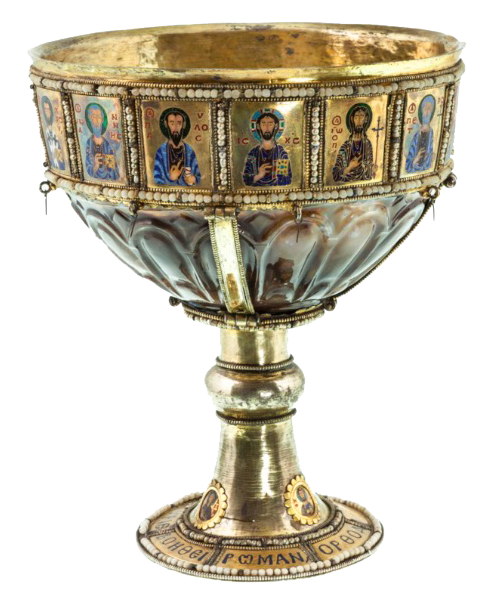 Chalice of the Emperor Romanos II
Chalice of the Emperor Romanos II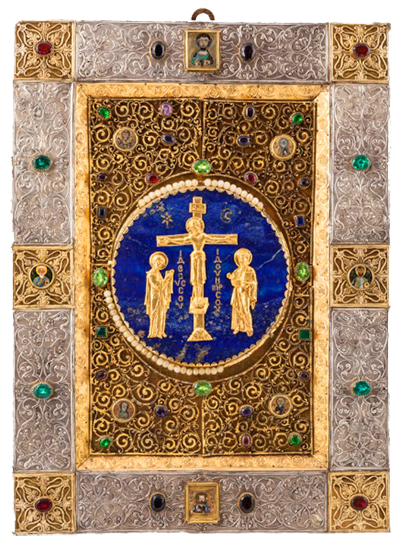

 Wanting to create my own virtual Byzantium at home, I painted the walls of my bedroom with life-sized saints, Christ and angels. I created my first icons when I was 9 and opened my own 'Byzantine Museum' in my bedroom. Not having any Byzantine artifacts of my own, I created mosaics, crosses, sculptures and reliquaries to stock the exhibit cases in my room. I created my own guidebooks to this 'collection' and issued free tickets to kids in my neighborhood. I was both curator and docent for these exhibitions.
Wanting to create my own virtual Byzantium at home, I painted the walls of my bedroom with life-sized saints, Christ and angels. I created my first icons when I was 9 and opened my own 'Byzantine Museum' in my bedroom. Not having any Byzantine artifacts of my own, I created mosaics, crosses, sculptures and reliquaries to stock the exhibit cases in my room. I created my own guidebooks to this 'collection' and issued free tickets to kids in my neighborhood. I was both curator and docent for these exhibitions.
 I was 6'5" tall when I was in 6th grade, 12 years old. I was a giant, that is the reason was never bullied or bothered about my art when I was in school. Everyone was afraid of me. I won many awards for my art when I was in Junior High and High School, I suppose kids gave me a break because I had talent, too, besides my size. I had two brothers who were much shorter than I was, we all looked like Vikings. My nickname was Atch, my younger brother was Itch, and the youngest and smallest of us was called Scratch. Both of my brothers were major athletes and hunters. I had no interest in shooting deer, bear and elk. My grandfather was a butcher so all that game ended up on our dinner table. I hated elk burgers and bear hot-dogs was even worse. My father decided I needed toughening up so one night he locked me in the garage were 4 deer were hanging from the rafters and dripping blood. I had to watch them staring at me all night in the darkness. Early in the morning I broke out off the garage and ran away from home for a few days. Our house was loaded with guns of all types and sizes - and there were bullets everywhere. Our house always reeked of gun cleaning supplies. Most of the guns were kept in my bedroom - right alongside the frescoes I had done in there. My parents never saw a conflict between Christ, the Prince of Peace and 24 rifles in wooden racks next to each other.
I was 6'5" tall when I was in 6th grade, 12 years old. I was a giant, that is the reason was never bullied or bothered about my art when I was in school. Everyone was afraid of me. I won many awards for my art when I was in Junior High and High School, I suppose kids gave me a break because I had talent, too, besides my size. I had two brothers who were much shorter than I was, we all looked like Vikings. My nickname was Atch, my younger brother was Itch, and the youngest and smallest of us was called Scratch. Both of my brothers were major athletes and hunters. I had no interest in shooting deer, bear and elk. My grandfather was a butcher so all that game ended up on our dinner table. I hated elk burgers and bear hot-dogs was even worse. My father decided I needed toughening up so one night he locked me in the garage were 4 deer were hanging from the rafters and dripping blood. I had to watch them staring at me all night in the darkness. Early in the morning I broke out off the garage and ran away from home for a few days. Our house was loaded with guns of all types and sizes - and there were bullets everywhere. Our house always reeked of gun cleaning supplies. Most of the guns were kept in my bedroom - right alongside the frescoes I had done in there. My parents never saw a conflict between Christ, the Prince of Peace and 24 rifles in wooden racks next to each other.


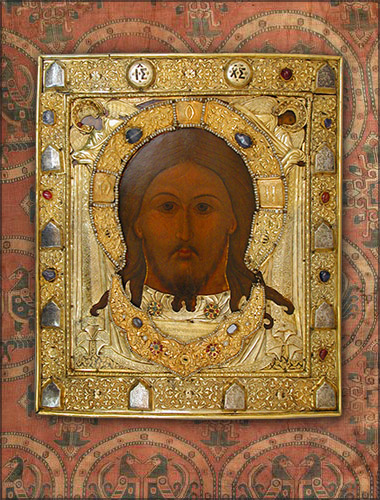
 click here for icons of christ
click here for icons of christ click here for icons of the theotokos
click here for icons of the theotokos click here for icons of angels
click here for icons of angels click here for icons of saints
click here for icons of saints








